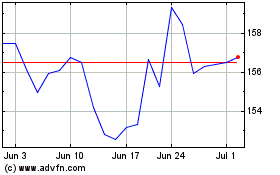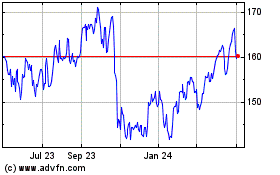Chevron North Sea Limited today announced it has started
production at Alder, a high-pressure, high-temperature (HPHT) gas
condensate field in the Central North Sea.
This Smart News Release features multimedia.
View the full release here:
http://www.businesswire.com/news/home/20161107005181/en/
(Photo: Business Wire)
"First gas at Alder represents a significant milestone for
Chevron and highlights our commitment to investing and developing
resources in the U.K.,” said Greta Lydecker, managing director,
Chevron Upstream Europe. “The safe and successful completion of
this project was underpinned by strong collaboration between
Chevron and Alder co-venturer ConocoPhillips. Alder supports our
goal of helping maximize the economic recovery of the U.K., adds
significant production to our portfolio, and helps extend the field
life of Britannia, an important asset to Chevron in the North
Sea.”
Andy Samuel, chief executive at The Oil and Gas Authority, said:
“We are very pleased to see the safe flow of first gas from the
Alder Field. Chevron’s application of innovative subsea
technologies and use of the U.K.’s experienced supply chain is
closely aligned to the Maximising Economic Recovery Strategy,
adding reserves and extending the life of an existing asset.”
Alder is a single subsea well tied back, via a 28 kilometer
pipeline, to the existing ConocoPhillips-operated Britannia
Platform, in which Chevron holds a 32.38 percent non-operated
working interest. The project has a planned design capacity of 110
million cubic feet of natural gas and 14,000 barrels of condensate
per day. Production from the HPHT Alder Field is expected to ramp
up over the coming months.
More than 70 percent of the Alder development work was executed
by U.K. based companies, providing significant investment to the
U.K. supply chain. The contracts supported several hundred jobs
across a range of U.K. locations including Aberdeen, Invergordon,
Leeds and Newcastle.
Discovered in 1975, the development has been enabled through the
application of innovative subsea technologies designed to meet the
temperature and pressure challenges of Alder. Key technologies have
included a number of firsts for Chevron in the North Sea, including
a vertical mono-bore subsea tree system; a subsea high integrity
pressure protection system (HIPPS); and a specially designed
corrosion monitoring system to measure the real-time condition of
the production pipeline.
Chevron Upstream Europe (CUE) is a strategic business unit of
Chevron’s Europe, Eurasia and Middle East (EEME) Operating Company,
and is headquartered in Aberdeen, Scotland. CUE manages the
company’s upstream exploration and production interests in Denmark,
Greenland, Norway and the United Kingdom. Chevron currently has
over 800 upstream staff and contractors across its European
operations, including the Global Technology Centre (GTC) in
Aberdeen.
In the United Kingdom, Chevron North Sea Limited (CNSL) has
working interests in 10 offshore producing fields, including three
operated fields (Alba, 23.4 percent; Captain, 85 percent; and
Erskine, 50 percent) and seven non-operated fields (Britannia, 32.4
percent; Brodgar, 25 percent; Callanish, 16.5 percent; Clair, 19.4
percent; Elgin/Franklin, 3.9 percent; Enochdhu, 50 percent; and
Jade, 19.9 percent). CNSL’s net daily production in 2015 from these
fields averaged 40,000 barrels of liquids and 115 million cubic
feet of natural gas. More information about Chevron in the UK is
available at www.chevronunitedkingdom.com
Notes to editors:
- The Alder Field was discovered in
1975.
- Alder is a high-pressure;
high-temperature (HPHT) gas condensate field located around 100
miles (160 km) from the Scottish coastline in the Central North
Sea, in water depths of approximately 492 feet (150 m).
- Alder is a single subsea well tied back
to the existing Britannia Bridge Linked Platform (BLP) via a 17.4
mile (28 km) production flowline.
- Alder produced fluids are processed at
a dedicated module attached to the Britannia BLP. Alder condensate
will be exported via the Forties Pipeline System to Grangemouth
terminal and gas exported to the Scottish Area Gas Evacuation
terminal at St Fergus, near Peterhead, Scotland.
- The project has a design capacity of
14,000 barrels of condensate and 110 million cubic feet of natural
gas per day.
- Alder brings a new stream of production
to Chevron and the U.K. while helping to extend the field life of
Britannia.
- More than 70 percent of Alder’s key
contracts were placed with U.K. companies.
- Technology and innovation have been key
to unlocking the potential of the Alder Field.
- Alder is operated by Chevron North Sea
Limited (73.7 percent); ConocoPhillips (U.K.) Limited holds a 26.3
percent interest in the field.
CAUTIONARY STATEMENTS RELEVANT TO
FORWARD-LOOKING INFORMATION FOR THE PURPOSE OF “SAFE HARBOR”
PROVISIONS OF THE PRIVATE SECURITIES LITIGATION REFORM ACT OF
1995
This press release contains forward-looking statements relating
to Chevron’s operations that are based on management’s current
expectations, estimates and projections about the petroleum,
chemicals and other energy-related industries. Words or phrases
such as “anticipates,” “expects,”“intends,” “plans,” “targets,”
“forecasts,” “projects,” “believes,” “seeks,” “schedules,”
“estimates,” “may,” “could,” “should,” “budgets,” “outlook,” “on
schedule,” “on track” and similar expressions are intended to
identify such forward-looking statements. These statements are not
guarantees of future performance and are subject to certain risks,
uncertainties and other factors, many of which are beyond the
company’s control and are difficult to predict. Therefore, actual
outcomes and results may differ materially from what is expressed
or forecasted in such forward-looking statements. The reader should
not place undue reliance on these forward-looking statements, which
speak only as of the date of this report. Unless legally required,
Chevron undertakes no obligation to update publicly any
forward-looking statements, whether as a result of new information,
future events or otherwise.
Among the important factors that could cause actual results to
differ materially from those in the forward-looking statements are:
changing crude oil and natural gas prices; changing refining,
marketing and chemicals margins; the company's ability to realize
anticipated cost savings and expenditure reductions; actions of
competitors or regulators; timing of exploration expenses; timing
of crude oil liftings; the competitiveness of alternate-energy
sources or product substitutes; technological developments; the
results of operations and financial condition of the company's
suppliers, vendors, partners and equity affiliates, particularly
during extended periods of low prices for crude oil and natural
gas; the inability or failure of the company’s joint-venture
partners to fund their share of operations and development
activities; the potential failure to achieve expected net
production from existing and future crude oil and natural gas
development projects; potential delays in the development,
construction or start-up of planned projects; the potential
disruption or interruption of the company’s operations due to war,
accidents, political events, civil unrest, severe weather, cyber
threats and terrorist acts, crude oil production quotas or other
actions that might be imposed by the Organization of Petroleum
Exporting Countries, or other natural or human causes beyond its
control; changing economic, regulatory and political environments
in the various countries in which the company operates; general
domestic and international economic and political conditions; the
potential liability for remedial actions or assessments under
existing or future environmental regulations and litigation;
significant operational, investment or product changes required by
existing or future environmental statutes and regulations,
including international agreements and national or regional
legislation and regulatory measures to limit or reduce greenhouse
gas emissions; the potential liability resulting from other pending
or future litigation; the company’s future acquisition or
disposition of assets and gains and losses from asset dispositions
or impairments; government-mandated sales, divestitures,
recapitalizations, industry-specific taxes, changes in fiscal terms
or restrictions on scope of company operations; foreign currency
movements compared with the U.S. dollar; material reductions in
corporate liquidity and access to debt markets; the effects of
changed accounting rules under generally accepted accounting
principles promulgated by rule-setting bodies; the company's
ability to identify and mitigate the risks and hazards inherent in
operating in the global energy industry; and the factors set forth
under the heading “Risk Factors” on pages 21 through 23 of the
company’s 2015 Annual Report on Form 10-K. Other unpredictable or
unknown factors not discussed in this report could also have
material adverse effects on forward-looking statements.
View source
version on businesswire.com: http://www.businesswire.com/news/home/20161107005181/en/
ChevronSam Howard, +44 1224 334056
(Aberdeen)Sam.Howard@chevron.comorSally Jones, +44 560 109 1435
(London)JonesS@chevron.com
Chevron (NYSE:CVX)
Historical Stock Chart
From Mar 2024 to Apr 2024

Chevron (NYSE:CVX)
Historical Stock Chart
From Apr 2023 to Apr 2024
